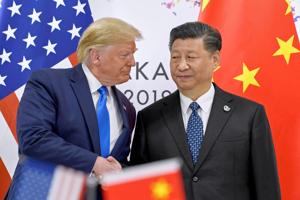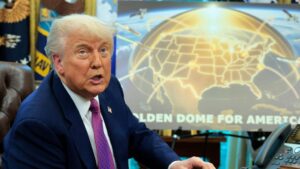
President Donald Trump announced plans on Friday to impose a staggering 100% tariff on Chinese imports, effective as early as November 1, 2025. This announcement marks a significant escalation in ongoing trade tensions between the United States and China, as the president cited recent export controls imposed by China on rare earth elements as a driving factor behind the decision.
In a post on his social media platform, Trump stated, “starting November 1st, 2025 (or sooner, depending on any further actions or changes taken by China), the United States of America will impose a Tariff of 100% on China, over and above any Tariff that they are currently paying.” This potential increase in tariffs could rekindle fears of a global economic downturn, reminiscent of the turmoil felt in April when similar threats were made.
Impact on Global Markets
The announcement came after financial markets had closed, leading to immediate concern regarding its implications for the global economy. The S&P 500 index plunged by 2.7% on Friday, reflecting investor anxiety over the renewed threat of a trade war. It was the largest single-day drop since April, indicating that Wall Street is sensitive to such developments.
Trump’s tariff threat follows a string of tensions, including China’s recent restrictions on the export of rare earth materials, which are crucial for a variety of technologies, from electronics to military applications. Beijing’s new regulations require foreign companies to obtain special approvals to export these materials, intensifying the standoff between the two nations.
China’s export controls were seen as a direct response to U.S. sanctions against Chinese companies, indicating an ongoing cycle of retaliation that could further complicate trade relations. Analysts warn that the increased tariffs could lead to a complete breakdown in trade between the U.S. and China, potentially stalling global economic growth.
Political Context and Future Negotiations
Trump’s announcement also calls into question his planned meeting with Chinese President Xi Jinping at the upcoming Asia-Pacific Economic Cooperation (APEC) summit in South Korea. In his post, Trump remarked, “there seems to be no reason” to meet with Xi under the current circumstances, highlighting the deteriorating diplomatic relations between the two countries.
While Trump’s words were definitive, his history of retracting threats leaves room for speculation about the likelihood of these tariffs being implemented. The potential for a trade war had previously led to negotiations that reduced tariffs to 30% on Chinese goods and 10% on American exports. With the new threats, the fragile peace established through these negotiations appears to be at risk.
Experts like Sun Yun, director of the China program at the Stimson Center, suggest that there is still room for de-escalation. “It is a disproportional reaction,” she noted, indicating that both sides may need to reconsider their positions to facilitate constructive dialogue.
Trump’s tariff proposal not only raises concerns about international trade but also poses risks to domestic U.S. economic stability. As the nation grapples with inflation and a fragile job market, analysts fear that these new tariffs could exacerbate existing economic challenges. Gracelin Baskaran, director of the Critical Minerals Security Program at the Center for Strategic and International Studies, emphasized that these restrictions undermine the U.S. industrial base at a critical time.
As tensions mount, the effectiveness of Trump’s trade policies remains uncertain. The stakes are high, with both nations now actively reaching for economic tools that could disrupt their relationship further. The world watches closely as the situation develops, uncertain about the implications for global trade and economic stability.






